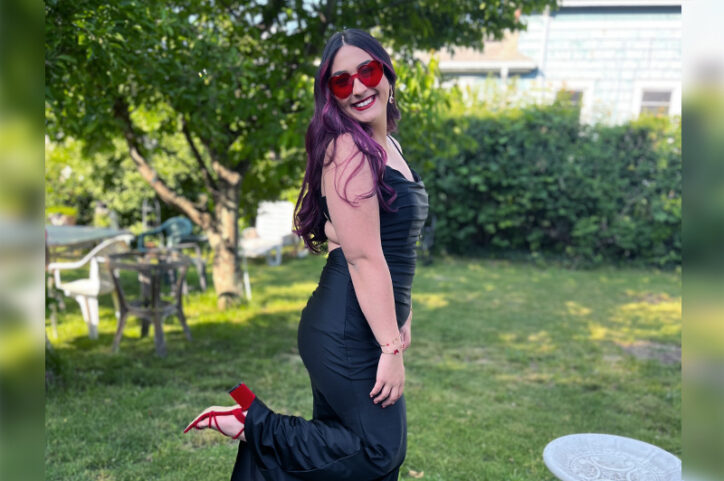‘It’s worth it’: Dianna finds support in managing her chronic pain

For Dianna Aguiar, 18, playing tennis, practicing yoga, and going for walks with her dog aren’t just fun ways to stay active. They’re powerful proof of how far she’s come in her journey with chronic pain. Although Dianna has had juvenile arthritis since she was a child, she began experiencing new back and hip pain several years ago, which didn’t seem to be tied to arthritis.
After being seen in the Chronic Pain Clinic at Boston Children’s, she joined a waiting list for the hospital’s Pediatric Pain Rehabilitation Center (PPRC), an intensive day program for kids and teens with chronic pain that hasn’t improved with other treatments. In the meantime, Dianna tried lidocaine injections to ease the pain, with little success. Then, earlier this year, she learned that she now qualified for Boston Children’s new Young Adult Pain Rehabilitation Program, which is similar to the PPRC but for young adults ages 18 to 26.
“I was nervous at first,” she says of the day she started the program. “But everyone in the program was so welcoming — I felt like I belonged.”

Gaining control and learning to cope
Simply getting out of bed to drive into Boston regularly was a major step for Dianna. By the time she entered the Young Adult Pain Rehabilitation Program, her pain was so debilitating that she had trouble waking up in the morning and had missed so many days of high school that she eventually dropped out. “I wasn’t going to school, I wasn’t working, and I wasn’t seeing my friends as much,” she explains. “I was exhausted.”
Today, just a few months after completing the young adult program, Dianna is successfully managing her pain using the strategies she learned there. She’s about to receive her GED and is looking forward to starting esthetician school this winter. Here, she shares some of the insight she’s gained from her experience with the Young Adult Pain Rehabilitation Program.

It takes a team of people — including you. Like the PPRC, the young adult program is staffed by a team of specialists from different disciplines to address all aspects of chronic pain, including physical therapists, occupational therapists, recreational therapists, psychologists, social workers, and pain medicine doctors. With gentle encouragement from Drs. Navil Sethna and Christine Greco, occupational therapist Paige Brousseau, psychologist Leah Reece, social worker Lisa Volpigno, and others, Dianna says she felt comfortable pushing herself.
“Everyone had a great attitude — and so did I,” she says. “They made me feel supported and like, ‘You’ve got this.’”
It’s okay to pace yourself. When her pain was at its worst, Dianna struggled to function without taking naps throughout the day. The team showed her how to safely get active again while taking breaks as needed.
“They taught me that I can pause, adjust, and cater activities to what works for me,” she says. Today, she’s back to enjoying tennis and is learning yoga.
Don’t neglect your mental health. Chronic pain and anxiety can often go hand in hand: Research suggests that people with chronic pain are more likely to develop anxiety, while anxiety can exacerbate pain, leading to a vicious cycle.
“I have a hard time talking about my anxiety, but Leah made me feel comfortable,” says Dianna. Working with Reece, she learned how to challenge negative thoughts, while the team’s recreational therapist taught her how to use crocheting, putty, and even coloring books as coping strategies to distract from pain and anxiety.
Take support when it’s offered. Although the prospect of getting her GED seemed overwhelming, Dianna knew it was something she wanted to achieve. She credits Volpigno and Reece with helping her navigate the process, start working again, and find a therapist during the young adult program. “Even now that I’ve finished, they’ve stayed in touch and want to hear about all my milestones.”
Although Dianna still has pain, she feels more in control and better able to manage it since completing the young adult program. “It sounds a little corny, but it helps to push yourself out of your comfort zone,” she says of her experience at Boston Children’s. “It’s worth it.”
Learn more about the Young Adult Pain Rehabilitation Program.
Related Posts :
-

‘Worth the trip’: Aiden and his family found help for chronic pain in Boston
Aiden Kozak loves playing volleyball — and he’s good at it. He was even recently named one of the top 50 ...
-

Get answers about your child's chronic pain
[smartslider3 slider="8"]
-

Chronic headaches in kids: How a psychologist can help your child cope
For many young people, the pain of chronic daily headaches can be compounded by the concern that providers aren’t ...
-

'On fire' with sJIA: When arthritis is much more than joint pain
Georgia is finally living her best life. Her toddler years were challenging: At 15 months old, a series of high fevers ...





